Book 5. Smolensk State Museum-Reserve (Lost items - 3527 )
History of the Smolensk Regional Museum collections held in the department of local region nature in 1941-1943
The present edition (volume 7, book 5) continues the list of valuable items missing from the Smolensk museum during World War II. It is the first attempt to assess damage to natural history collections. The Catalogue includes only those items that were restored by inventory records and archival documents.
It should be noted that the present publication does not reflect the full extent of losses to the nature department. The Catalogue does not include non-inventoried items and exhibits not coded COМ П№ (Smolensk Regional Museum, serial number) as well as equipment, exposures, laboratories, weather stations and an extensive library.
The Natural History Museum, or as it was called later, “Museum of Local Nature”, “Natural History Museum named after N. M. Przewalski”, was founded in 1908. The museum was originated as a private initiative of agronomy circle for the study of Smolensk region, natives of Smolensk, who studied at Moscow universities, and Society for the study of Smolensk province (hereinafter the “Society”).
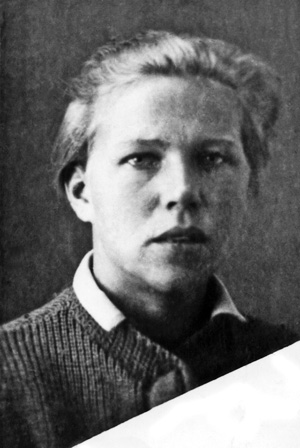
E. V. Burkina.
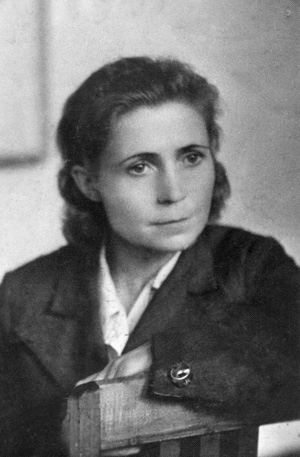
A. I. Debrina.
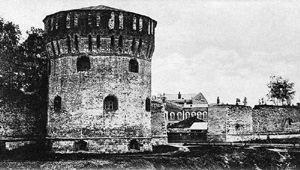
Gromovaya Tower of Smolensk fortress wall
(1596-1602) as it looked during
the World War II.
Establishing the museum, the Society aimed at: a) gathering as complete as possible natural history collections of Smolensk province, such as geological, mineralogical, botanical and zoological ones; collections in ethnography, agriculture; photographs of localities, people, animals, plants, etc.; b) scientific research and description of museum’s collections; c) giving the public, particularly the younger generation, an insight of local nature.[1]
The founders of the Society developed “Directions for assembling materials and collections” which were distributed to the public. Lovers of natural history, citizens, villagers, public institutions, scientists responded warmly to this call. On November 14, 1914, when museum was opened to the public, a considerable number of exhibits was congregated, namely 10 stuffed mammals; 155 stuffed birds belonging to 101 species; 37 jars with alcohol preparations of fish and reptiles; 10 boxes of insects, herbarium, consisting of 10,000 specimens; collections of seeds, fertilizers, minerals; photographs; statistical tables; maps, and archaeological collections. Collection also included numismatic artifacts found in land of Smolensk.[2] From the above figures it is clear that botanical collection was the most important.
The Board of Society appointed Grigory Leonidovich Grave (1872-1957) the first curator of the museum.
Both amateurs and scientists have studied the flora of the Smolensk land. V. V. Dombrowsky supplied the museum with 118 mounted plants collected in the northeastern part of Porechye district and six volosts of Smolensk district. V. V. Stepanov presented to museum herbarium comprising 566 species of plants collected in Khokhly and Bogoroditskoe volosts of Smolensk district. S. A. Pervukhin donated herbarium of 214 species of plants collected in the vicinity of Smolensk. D. I. Smirnov compiled herbarium of 96 species in Dukhovshchina district.[3]
The agronomy circle for the study of Smolensk region which membership included princesses E. K. Sviatopolk-Chetvertinskaya and М. K. Tenisheva, G. L. Grave, V. N. Kaverznev, I. A. Sinyagin, A. G. Grzybowski, V. A. Melander, V. N. Dobrowolsky, V. A. Lidin, S. S. Chetyrkin, E. V. Dombrovskaya, and others, made great contributions to the museum’s collections.
Botanist Ya. Ya. Alekseev graduated from Yuryev University, and Moscow University alumni A. Z. Imshenetsky and N. A. Komarnitsky conducted detailed botanical research in the Smolensk district involving the collection of herbarium specimens as well as the surveying and mapping of plant communities.
In the expeditions, photographers often collaborated with scientists. I. F. Barshchevsky (1851-1948), one of the best Russian photographers, the creator and curator of museum “Russian Antiquity” in Smolensk, was the major contributor to the photo-records of Smolensk regional nature. He has been photographing on Kuprinskoye, Chernoye, Lagivskoye, Babichskoye lakes, and moss bogs.
V. A. Lidin (1868-1942), music teacher, head of Talashkinskino Art Studios, took photographs of plants on the banks of the Dnieper River.
In addition to the museum, the Society attached great importance to collecting the library. The organizers tried to concentrate in the library “all the literature in some way related to the Smolensk province,” which could be of help for local naturalists, who did not often have at hand necessary manuals.
The first gift, 70 volumes of books, was received from students’ agronomy circle. Then big donations came from princess E. K. Sviatopolk- Chetvertinskaya, professor K. D. Glinka, historian and ethnographer V. I. Grachev, ethnographer and linguist V. N. Dobrowolsky, local historian, archaeologist E. N. Kletnova, Provincial statistics committee, and many others. By the opening of the museum, the library outnumbered 300 volumes.[4]
Scientific research and purchase of library books were funded by individuals and institutions such as Provincial zemstvo assembly, Smolensk uyezd zemstvo assembly, Main department of lands and agriculture, City Duma. Among the donors, museum records mention М. I. Pogodin, A. A. Cheplevsky, К. K. Aref’ev, N. N. Redkov, V. V. Stanchinsky, E. I. Barshchevskaya.
On the eve of the revolution of 1917, museum housed the following catalogued specimens: 41 pieces of stuffed mammals and skins; 189 stuffed birds and skins; 42 alcohol preparations of fish and reptiles, more than a thousand specimens of insects and up to 10,000 herbaria,[5] as well as statistical tables, maps, mineralogical, geological, archaeological, numismatic collections.
In 1920, the museum came under the management of Smolensk subdivision for museum affairs and heritage preservation. By that time, the collection comprised more than 15,000 items and special library.[6]
New authorities renamed the museum “Smolensk State Natural History Museum of the local region”.[7] It comes under the management of Glavnauka and becomes the department of the State Museum.
Having good financial and physical supply, the museum has started active research. Employees conducted systematic scientific expeditions to study topography, soils, flora and fauna of Smolensk land. Museum’s collections were replenished with obtained specimens. The museum set up a laboratory for biological research, weather station was functioning. Jointly with the Society, biological station was established in the hamlet Fomino near Kuprinskoye lake. At the station, hydrobiological research was carried out as well as observations on the sponges and gathering materials for sponge collection. Surveys of farm and forest pests enabled the researches to compile a collection illustrating ontogenesis of insects and their “protective coloration” (33 boxes) as well as the systematic collection of insects (up to 300 items). Studies of plant communities and the collection of herbarium specimens were also conducted.
Along with museum employees, biologists V. A. Melander, G. L. Grave, preparator A. P. Komanetsky, lecturers of Moscow State University (MSU) took part in the expeditions as well as professor of botany at Smolensk university Ya. Ya. Alekseev.
The museum maintained close contact with Moscow State University, Institute of spore-bearing plants at the Main Botanical Garden in Leningrad and institutes of Smolensk. Thorough and systematic study of the local region enabled the replenishment of the pre-revolutionary museum collections and their expanding.
It is noteworthy that the collection included natural history materials obtained in other parts of the world. Among them, the items received in 1920 constitute a special group. These were collections, compiled and owned by the great Russian explorer N. M. Przewalski (1839-1888): head and hooves of yak, horns of turs and antelopes, wild boar tusks, stuffed bears, tusks, stuffed birds, a variety of plants collected during expeditions to Central Asia, more than 150 full-scale drawings and watercolors made by V. I. Roborovsky during the third expedition to Central Asia, headed by N. M. Przewalski. All these specimens were kept in Sloboda estate of N. M. Przewalski. On instructions from Narkompros, N. M. Przewalski’s successor, explorer P. K. Kozlov (1863-1935) brought them back and delivered to the Museum of Smolensk. Later he donated to museum his collections of beetles and hymenoptera, Tangut and Mongol weapons.
S. S. Chetyrkin (1876-1938), researcher, archaeologist, explorer, zoologist, botanist, member of the Mongol-Sichuan Expedition of P. K. Kozlov and the expedition of V. A. Rusanov (1875-1913?) to Novaya Zemlya, supplied the museum with stuffed birds, wet specimens of 26 lizards, scorpions collected in the desert of Mongolia; sea urchins, sea stars, sea lilies, dolphin skull, snails, birds, fish, corals, obtained in Atlantic, Indian, Arctic Oceans, White and Kara Seas.
By 1930, the museum had on display five sections: 1) botany, 2) zoology, 3) entomology, 4) geology and paleontology, 5) department of non-local fauna and collections in memory of N. M. Przewalski.[8] The museum reports of that time were emphasized that from all the collections of the museum, the bird fauna (90% of the total number of species known in the Smolensk region), and mammals (50-70% represented) had the most extensive taxonomic coverage. The library comprised of 1224 items, and 980 items from the personal library of N. M. Przewalski.
In 1931, due to various reorganizations in the network of museums, as well as “cleansings” carried out among employees, collections of natural history department were partly transferred to Smolensk medical and pedagogical institutes. March 13, 1938, the meeting of Bureau of the Smolensk Regional Committee of the CPSU(b) took a resolution on the return of exhibits from the institutes, and allocation of separate building for natural history collections.[9] Thus, the museum had at its disposal Gromovaya Tower of Smolensk fortress wall. It should be noted that the museum never had its own building and had constant troubles with the layout of displays and the placement of exhibits.
After bringing their collections in one place (it was not without the losses, not all exhibits returned from institutions), the staff quickly set up the exhibition.
We know what it looked like, from recently founded document dated May 8, 1939. It briefly describes the display which entered the tragic day June 22, 1941, with the museum.
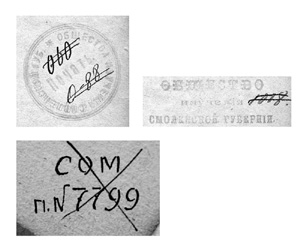
Seal, stamp, and number on exhibits
of the Smolensk Museum of Natural History
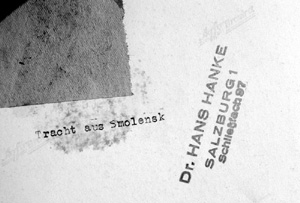
Stamp on the photos, removed from Smolensk
museum and returned from Germany in 2009.
Part of the document is entitled “Information on the department of nature.” Further it says: “The exhibition section “Animals of the Smolensk region” is represented by the vertebrate fauna. Among fish, such rare species for Smolensk region, as sabrefish and brook trout, and mirror carp and whitefish acclimatized here are especially noteworthy (all of them are wet specimens). Birds are most fully represented. More than 80% of the avifauna of the region occurs at the exhibition museum as stuffed animals and biogroups. Some of the rarest species are worth noticing: ed-throated diver, black brant, whooper swan, red-crested pochard, golden eagle, white-tailed eagle, water rail, little crake, gull-broody, azure tit, and several others. Besides the systematic collection, there are the exhibits of the economic kind. Of particular interest is “shore of lake”, which shows the shallow and water, thickets of sedges, bulrush, coastal water and fauna (text lost) <...> is equipped with panorama (oil-painted). Mammals are represented <...>. In addition to ones ordinary for the region bears, elk, wolf, fox, badgers, etc., a stuffed animal <...> beaver, living in several rivers, as well as acclimatized muskrats and raccoon dogs (stuffed animals and skins). To illustrate the variability, biogroup “wild pigeons” is displayed, where the birds (10 stuffed ones) with various deviations from the normal type of color are selected. Sexual dimorphism is shown by a pair of long-tailed ducks (male and female). Stuffed goatsucker on the tree bough, as an example of mimicry. Stuffed cuckoo and sparrow hawk, as an example of mimetic coloration.
The section devoted to N. M. Przewalski was dedicated to the centenary of the birth of a traveler. On display are exhibits either directly related to the life and travels of N. M. Przewalski, or were taken out from Central Asia by the expeditions of P. K. Kozlov. These are collection of beetles and Hymenoptera, Tangut and Mongol weapons.
An important place of the exposition is occupied with original drawings, performed in expeditions by V. I. Roborovsky, the companion of the great explorer. The department has about 150 such images at its disposal, as well as large herbarium, compiled by N. M. Przewalski in the Chansu and Alashan mountains and elsewhere in Central Asia. Animals are presented by stuffed Tibetan blue bear, blood pheasans, black redstarts, desert finches, etc. Reptiles of Central Asian deserts are represented as wet specimens <...>. In addition, the department disposes of a part of the personal library of N. M. Przewalski, and several autographed books...” This document has a special meaning for us, as it identifies a number of exhibits that have been missed during the war and therefore not included in this Catalogue.
At the outbreak of the war, Smolensk museums proved to be in a very tight situation. State evacuation plan included saving cultural property, but in town, which came under massive bombing at the very onset of World War II, museums were sidelined. Finding ways to safeguard historical and artistic treasures has become the goal for museum staff.
Yefrosinya Vasilyevna Burkina (1906-1978) directed the evacuation. One of her greatest helpers has been the head of the department of nature, Anna Iudovna Debrina. One freight wagon was allocated to the museum, which was loaded with gold and silver articles, a part of the collection of paintings, icons, books, documents and weapons. From the department of nature A. I. Debrina managed to take only two stuffed animals (Ussuri raccoon and muskrat) and four inventory accounts. A. I. Debrina was assigned to escort a group of museum specimens. On the night of July 9, 1941, the echelon, comprising the freight wagon with museum collections, left for the city of Gorky.
The museum’s collections remained in the town, met a tragic fate. After the departure of A. I. Debrina, no one member of the department stayed in the town and the museum was unattended. After the onset of town occupation, all the museums were confiscated.
In wartime documents compiled by employees of other departments, natural history collection was not mentioned. In the first months of occupation the museum evidently had not been looted. This assumption is confirmed by the head of the main working group “Ostland” Otto Nerling who wrote in his report of May 17, 1942: “At preservation of museums (in Smolensk. - V. S.) we had, in general, to overcome much less difficulty, since all the items could stay at their original places...” Apparently, the natural history museum became the object of special attention of the occupation authorities.
That’s why in November 1942, the researcher Dr. Henke arrived in the city. With the approval of Rosenberg Staff, he choose at natural history museum 18 pieces of horns of rare animals brought by N. M. Przewalski from expeditions, for the “Haus der Natur” of Salzburg. Yielding of items was confirmed by the acceptance report dated November 26, 1942, with the signature of the person issuing exhibits. Graph for the signature of the person receiving the items is not filled. The document also stated that the exhibits were obtained for sustained use. A collection of horns was kept in the building of the Gromovaya Tower and belonged to the exhibition devoted to N. M. Przewalski.
Unfortunately, we have no documentary evidence that the rest of the collection came also to the museum of Salzburg. But the building remained intact during the war, and the collection nearly completely missed. The entire scientific archive department was gone, too. We can assume that German museum professionals could not help but be interested in rare in its completeness zoological, botanical, paleontological and archaeological collections, which were gathered by the scientists for more than 33 years.
This assumption is indirectly documented. November 27, 1945 Russian and foreign officers performed an inspection of Smolensk Library located in the building of the museum “Haus der Natur” of Salzburg. There among the books they found “museum specimens such as birds, animals, insects on bases; geological materials, including six boxes of rocks and minerals as well as a pile of unpacked books. All these items were labeled with Russian stickers”. Library of nature department, unique by selection of books, also disappeared during the occupation. Given that the books brought from Smolensk were kept in museum “Haus der Natur”, we can assume that these natural history specimens and piles of unpacked books could well belong to the Smolensk Museum of Nature.
Several museum items, which were in medical and pedagogical institutes as teaching aids, were most likely removed with their libraries and archives. The letter by Otto Nerling of December 11, 1942 to Berlin says: removed (from Smolensk. - V. S.) remains of university and research institute libraries as well as “zoological and botanical specimens, physical devices”.
In the present context, estimation of the damage to nature department is not possible, because the entire archive was removed. Recently, according to the documents, it was established that the nature department comprised as follows: coins of Ioann IV, Fyodor Ivanovich, Boris Godunov, Sigismund III; dirhams; map of Smolensk province compiled by provincial land surveyor Belokopytov in the early 19th century; map of Smolensk province in the scale 3 versts, 28 pages; map of the southern part of Smolensk province in the scale 3 versts, 9 pages; map of Smolensk province in the scale 3 versts pasted on calico; codex donated by S. M. Sokolovsky, founder of the Roslavl Local History Museum; vegetation map of the northern part of Smolensk district, which was the result of research conducted by Ya. Ya. Alekseev; a large collection of photographs.
Honorary member of the Society for the study of Smolensk province V. V. Dombrovsky donated to the museum the largest iris diaphragm aperture device, production from E. Busch factory, for ethnographic and landscape photography. It was available for several plate sizes 18 x 24 cm with a diaphragm 24 x 30 cm, suitable for the reproduction of biological objects. Photographic still camera of mahogany for a plate of 24 x 24 cm with double extension bellows and cassettes was able to be placed in either vertical or horizontal positions. In addition, the museum’s archives included charts, diagrams, and reports of researchers. The library received books from Bureau of International bibliography of the Imperial Academy of Sciences, Podolsk Society of Naturalists and nature lovers, Kostroma Society for the Study of the local region, Vladimir Society of Naturalists, geological Committee (“Russian Geological Library for 1898”), Tula Scientific Archive Commission, Meteorological Bureau of the scientific committee of Main Department of Agriculture (“Proceedings of the Agricultural Meteorology”, Issues XI, XIV, XV and “Annals of the Agricultural Meteorology”), Tula Society of Naturalists (“News”), Nikolaev Central Physical Observatory (Daily weather bulletins), Department of Agriculture (publication on problems of combating agricultural pests), Saratov Society of Natural Scientists and Amateurs of Natural Science (studies of the Volga Biological Station), Smolensk and Moscow zemstvo boards. The library received also periodicals such as “Ornithological Bulletin” edited by G. I. Polyakov, “Russian photographic Bulletin” edited by G. S. Mikhailov-Muchkin, “Yearbook on Geology and Mineralogy of Russia” edited by N. T. Krishtafovich. The library comprised of: “Key of the Mammals of the Russian Empire” by K. A. Satunin; “Bulletin of Russian Flora”; “Smolensk ethnographic collection”, parts 1, 2 and 3 by V. N. Dobrowolsky, etc. Here are listed a number of scientific societies, with which Smolensk Natural History Museum maintained contact and exchanged publications.
At present, we are not able to establish how many and what specimens consisted the department of nature and its scientific reference library.
In 1967, 1162 volumes were returned to Smolensk libraries from Salzburg. In April 2009 our museum has received a compilation of photographs from Germany, which were taken out as trophies. Among them pictures of the museum’s “Russian Antiquity” items made in pre-revolutionary period, most likely by I. F. Barshchevsky. There is one photograph of the cradle of the Great Russian composer М. I. Glinka. During the war the memorial unique item was lost. A series of images shows the fragments of the unknown natural history exposure; views of settlements; landscapes; archaeological findings from Gnezdovo, stored in the historical and archaeological department and completely removed in November 1941.
Several photos are made by German photographers. They depicted people and scenes of everyday life of the occupied city, views of churches. Four photos are stamped on verso: «HANS HANKE SALZBURG Schllebfach 97 1». Apparently, this collection was privately owned by doctor Hanke, who had come to Smolensk to select natural history specimens. These facts inspire hope that the exhibits of Smolensk Museum of Nature, its library and scientific archive could survive the war years in Salzburg.
Re-registration of museum items began in 1939, when the museum received a code COM П№ approved by Narkompros. By June 9, 1939, the department of nature had re-registered 1552 items. Until the war one and a half years remained, and the department comprised more than 15 thousand exhibits. Two employees worked in the department. Hence, most of the subjects were not recorded in the inventory books. In 1944 the museum had drawn up a statement “On damage caused by Nazis...”[10] There the department of nature was the first, but the number of items was not specified. Mineralogical collections, stuffed animals, fish, birds, collections of N. M. Przewalski were listed, but without a single digit. By this act it is difficult to estimate how many items were lost. This is explained by the fact that the museum had not yet worked. Collections of the museum were partly evacuated, and the other artifacts were captured as trophies.
In February 1949, when the museum with great difficulty collected what was left, the picture of losses became clearer. The staff drew up a report on “the assessing the loss and the value of the exhibits of the Smolensk Natural History Museum, destroyed by the fascist barbarians in the period of occupation of the city of Smolensk in 1941-1943 and exported to Germany”.[11]
In the report on nature department are listed: geology, zoology, botany, 2259 exhibits. Each subject was assessed at 100 rubles. Apparently, this official figure was derived from the records in the partly preserved inventory books of the museum, that is, these 2259 tems should be coded COM П№.
By May 1955 the museum had compiled the lists of the lost items. They identified four departments: paleontology, 324; zoology, 571; botany, 1362 (from 10,000); geology, 3043. These lists do not include archaeology, numismatics, maps, diagrams, photographs, library, which were in the department before the war.
Compiling the catalogue of items lost during World War II is very complicated and troublesome. Smolensk and the museum archives suffered great loss. Inventories of Natural History Museum, but four separate books recorded at different times, have not survived. Since its foundation until 1941, the department did not edit catalogues. The documents referred to chronological and systematic (card) catalogs of birds and mammals, but they are missing. Numerical data in the archival documents (reports of the museum) are not supported by the lists and have numerous versions. Most often, botanical materials are recorded by folders, and insects, by the boxes. This book is the first attempt to summarize the losses of Natural History Museum.
The Catalogue is based on data taken from four inventory books of 1915?-1930s and accessory books of the museum, which were compiled in 1939-1941.
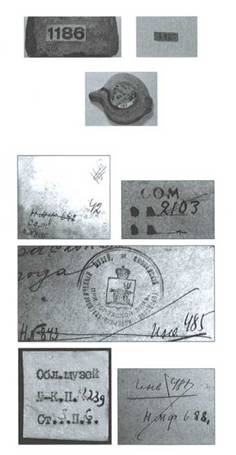
Samples of numbers and stamps on the photos
Lists compiled before 1930 indicate only the names of items and sometimes, the names of donors. The information on the composition of collections of N. M. Przewalski, P. K. Kozlov, S. S. Chetyrkin was obtained from these books.
Records in books of 1939 are very brief, often illegible, Latin names are often misspelled or absent. Geographical names also offered great difficulties. The same towns had multiple spellings. From 1917 to 1941, administrative-territorial division of the Smolensk region has undergone significant changes: some areas originally belonged to the Western region, and then went over to Moscow, Tver, Orel and Bryansk regions. A number of settlements ceased to exist (landed estates, hamlets, farms). Some inaccurate names had to be omitted. The possibility of distortion of the names of some lakes, swamps and villages cannot be excluded. In determining the site of gathering of natural history specimens, compilers have adopted the term “now”. For example, the locality in records is indicated in the Western region, the Catalogue says: “now Bryansk region.”
Because of lack of exhibits we failed to identify and visually reproduce inventory records (marking), which were given since 1908. The Catalogue specified only the last code COM П№.
In some cases provenance was not specified, or the term “From previous accessions” was used. Source income, recorded “From pedagogical institute” or “From medical institute” was not specified in this Catalogue, since these museum specimens were temporarily transferred to these institutions. Where possible, the compilers determined their provenance or noted: “From the Natural History Museum named after N. M. Przewalski”.
The dimensions of items are approximate, because the books do not stipulate what size was specified, of stand or exhibit. Examinations of item descriptions indicate that more often the size of stand and box were specified.
Problems with the entries in inventory books have arisen because in 1930s scientists and professionals who were at the beginnings of the museum have left the museum after political “cleansing”. Smart, conscientious employees replaced them, but they did not possess an encyclopedic knowledge of their predecessors. Therefore, in 1939 those artifacts were entered in the accessory book in the first place, that did not require deep knowledge, and more complex collections were left for later.
To restore the picture of losses of the museum, the compilers found it possible to include the lists drawn up in 1915?-1930s in the documented application made by scanning, as these items were not included in this list, but some of them are reflected in report of conveyance for Salzburg.
The Catalogue also contains a series of photos made from identical items and taken out of special editions. Photo archives of the museum are completely lost, and so far not a single snapshot of pre-war exhibition of natural-history museum or its exhibits was found.
Catalogue of the department of local nature consists of four sections with a single (shared) numbering:
1. Botany
2. Zoology.
3. Geology.
4. Paleontology.
In each section of the exhibits are ranged in increasing numbers of records. Information about the exhibits was introduced based on analysis of all the remained museum documentation. In the description of objects the compilers tried to save the original text of the books. The names were specified in the special indices and encyclopedias. Dimensions are given in the order in which they appear in inventory books. Preservation is indicated only where there is a description.
Of course, this Catalogue should not build a complete picture of the damage to collections of natural history museum. This amount of losses is yet to be established. We hope that in time top-secret archives will be available to researchers.
Now we publish only brief data which could be found. And if the loss of plants and animals that can be restored, is not so painful, the loss of archaeological, scientific archives, photo archives, collections of N. M. Przewalski, P. K. Kozlov, S. S. Chetyrkin, E. I. Barshchevskaya and their annotations are irreplaceable.
We have to work hard in the future to compile lists of items that were not included in the books of 1939—1941.
The Smolensk Museum-Reserve is grateful to the staff of the Ministry of Culture of the Russian Federation for methodological assistance. Special thanks to N. I. Nikandrov and S. D. Nekrasova for their great work on the search of archival documents and all possible assistance at the compiling the Catalogue.
V. I .Skleenova
Abbreviations
Glavnauka - the Central Administration for scientific, scholarly-artistic, and Museum Institutions.
COM П№ - the Smolensk Regional Museum, serial number (№).
Narkompros - People’s Commissariat for Education.
Ф., Об., Oп., Д., Л. - terms used for describing archival records in Russia.
Documentary application
A handwritten list of collections of the Smolensk Natural History Museum before World War II which have not undergone re-registration
The report assessing the loss and the value of the exhibits of the Smolensk Natural History Regional Museum during World War II. February 20, 1949.
The report of acceptance and transmission of the Smolensk Natural History Museum to the museum “Haus der Natur” in Salzburg for November 26, 1942.
Copy of the report on inspection the books removed from Smolensk libraries and stored at “Haus der Natur” of Salzburg
Appendix
Fragments of the exposition of the Historical and Archaeological Museum
Silver bracelet. The gift of N. K. Roerich
Fragments of the exposition of the Roslavl Museum
Photos and drawings to the archaeology section
[1] The report of Society for the Study of Smolensk province to January 1, 1912. Smolensk. Provincial printing. 1912. P. 10.
[2] The Report of Society for the Study of Smolensk province for 1913. Smolensk. Electro-type-lithography of Y. N. Podzemsky. 1914. PP. 11-12.
[3] A brief preliminary report of botanical studies in the summer of 1911. Smolensk. Provincial printing. 1911. PP. 4-5.
[4] The Report of Society for the Study of Smolensk province for 1912. Smolensk. Provincial printing. 1912. P. 12.
[5] The Report of Society for the Study of Smolensk province for 1915. Smolensk. Provincial printing. 1917. P. 8.
[6] GASO, State Archive of Smolensk region. - ГАСО. Ф.19. Оп. 1. Д. 1286. Л. 6.
[7] GASO, State Archive of Smolensk region. - ГАСО. Ф. 455. Оп. 4. Д. 2. Л. 38, 54.
[8] GANISO, the State Archive of contemporary History of Smolensk region, ГАНИСО - Ф. 6. On. 1. Д. 78. Л. 25-27
[9] The Smolensk Museum-Reserve. Archives of accounting.
[10] Archive of Smolensk regional directorate of the Federal Security Service (FSB). Д. № 13313 С. Л. 121.
[11] GASO, the State Archive of Smolensk region. - ГАСО. Ф. 455. Оп. 4. Д. 2. Л. 389(Об).
|




